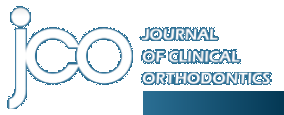Search Results For: 'orthodontics'
3001.
Volume 5 : Number 12 : Page 655 : Dec 1971
One of the annoyances that orthodontists encounter from time to time in extraction as well as in nonextraction cases is a slight crowding of mandibular incisors following orthodontic treatment. We hav...
3002.
THE EDITOR'S CORNER
Volume 18 : Number 1 : Page 9 : Jan 1984
Why Not a Cafeteria Plan? A cafeteria plan is a menu of employee fringe benefits from which an individual employee can select those benefits that she can use or would prefer up to a predetermined doll...
3003.
THE EDITOR'S CORNER
A Resurgence of Interest in Bioelectric Medicine
Volume 18 : Number 5 : Page 309 : May 1984
A Resurgence of Interest in Bioelectric Medicine The use of electrical currents in medicine is not new. Records indicate that electrical stimulation was prescribed as early as 46 A.D. Patients were ad...
3004.
Cephalometric Changes from Activator-Headgear Treatment of Class II, Division 1 Malocclusion
Volume 21 : Number 7 : Page 0 : Jul 1987
Cephalometric results from four orthodontic offices were collected to answer two questions about combined activator-headgear treatment of Class II, division 1 cases: What inhibition or stimulation of ...
3005.
THE EDITOR'S CORNER
Volume 22 : Number 2 : Page 0 : Feb 1988
The Advent of Ceramics Every few years some new procedure or material is offered as a major advancement that will solve orthodontic problems. In some instances, these advances have lived up to their e...
3006.
THE EDITOR'S CORNER
Volume 24 : Number 5 : Page 0 : May 1990
The Technology Gap Alvin Toffler wrote about the knowledge explosion and "future shock" in 1970. He predicted these two phenomena would have a significant impact on the human race, and he was right....
3007.
Direct Bonding with Reduced Acid Etchant Concentrations
Volume 27 : Number 1 : Page 0 : Jan 1993
Etching with phosphoric acid in concentrations of 20-50% has long been recommended for optimal bracket retention in direct bonding.1,2 However, a number of recent laboratory and clinical studies have ...
3008.
A Practical Biteplane for Use with Fixed Appliances
Volume 27 : Number 9 : Page 0 : Sep 1993
Biteplanes are often used when bracket interference makes it difficult to bond the lower anterior or even the lower posterior teeth at the start of treatment. Biteplanes are also needed in many cases ...
3009.
Use of the Arndt Nickel Titanium Palatal Expander in Cleft Palate Cases
Volume 29 : Number 8 : Page 0 : Aug 1995
Successful cleft lip and cleft palate rehabilitation requires a multidisciplinary approach employing the skills of plastic surgeons, speech therapists, pediatric dentists, and orthodontists. Since the...
3010.
Simplified Repositioning Splint Construction
Volume 30 : Number 10 : Page 578 : Oct 1996
Full-coverage acrylic splints with mutually protected occlusion are used in treatment of temporomandibular disorders and in other therapies. However, orthodontists have been concerned about the time-c...
3011.
Frictional Resistance of the Damon SL Bracket
Volume 32 : Number 8 : Page 485 : Aug 1998
Orthodontic brackets have been modified in several ways to decrease frictional resistance and improve the efficiency of sliding mechanics. These changes initially focused on bracket width,1-5 interbra...
3012.
A New Instrument for Controlled Bracket Positioning
Volume 36 : Number 4 : Page 206 : Apr 2002
Many techniques have been described to improve bracket positioning,1 involving several different instruments.2-4 Although the Boone and Dougherty gauges have been widely used,1,2,5,6 brackets can easi...
3013.
Distalization of Maxillary Molars with a Midpalatal Miniscrew
Volume 1 : Number 1 : Page 22 : Jan 2003
Traditional methods of controlling anchorage during molar distalization tend to cause unwanted movement of other teeth and to require patient cooperation. These disadvantages can be overcome with skel...
3014.
Intentional Ankylosis of Deciduous Canines to Reinforce Maxillary Protraction
Volume 37 : Number 6 : Page 315 : Jun 2003
Maxillary deficiency, either isolated or associated with mandibular prognathism, tends to be the main facial characteristic of Class III malocclusions.1-16 Many orthodontists prefer early treatment in...
3015.
MANAGEMENT & MARKETING
Hire Smart to Prevent Embezzlement Loss
Volume 37 : Number 7 : Page 373 : Jul 2003
Hiring and firing employees is a fact of life for any business, including orthodontic practices. Hiring smartly and firing well reduces costs, not only financially, but emotionally. By using time-test...
3016.
THE EDITOR'S CORNER
Volume 38 : Number 6 : Page 317 : Jun 2004
Did you ever have one of those days when it seems like the only things that don't go wrong are the ones that just don't happen at all? Not too long ago, I had a couple of those days almost back to bac...
3017.
Use of a Nickel Titanium Palatal Expander in Cleft-Palate Cases
Volume 38 : Number 7 : Page 374 : Jul 2004
After closure of a cleft lip and palate, the patient often experiences a collapse of the maxillary fragments, resulting in a poor occlusion and an inability to chew properly.1-5 While early surgical i...
3018.
Biomechanical Considerations in Treatment with Miniscrew Anchorage, Part 1: The Sagittal Plane
Volume 42 : Number 2 : Page 79 : Feb 2008
The use of miniscrews for reinforcement of orthodontic anchorage has become increasingly popular in recent years, especially in adult patients who do not want to wear extraoral appliances. Miniscrews ...
3019.
A 3D-Printed Miniscrew Insertion Stent
Volume 48 : Number 10 : Page 650 : Oct 2014
Three-dimensional printing offers a vast potential for orthodontic applications.1 Two 3D printing systems, stereolithography (SLA) and direct metal laser sintering (DMLS), have already gained populari...
3020.
DIAGNOSTIC CHALLENGE
Volume 59 : Number 1 : Page 67 : Jan 2025
In this monthly column, Contributing Editors Gayle Glenn, DDS, MSD, and Shawn L. Miller, DMD, MMSc, present a case to challenge your diagnostic and treatment-planning skills. The initial records for t...
Showing 3001-3020 of 4092 results. Search completed in 0.197 seconds.

